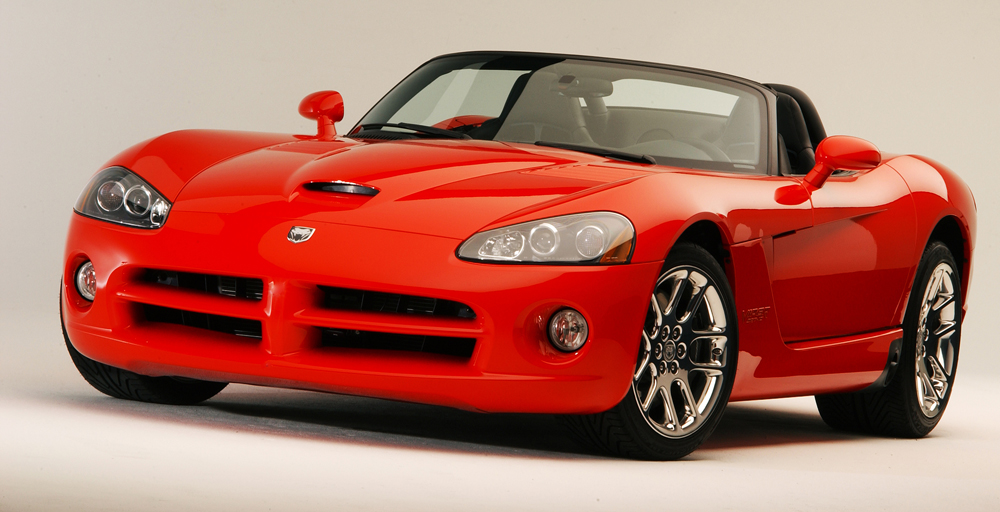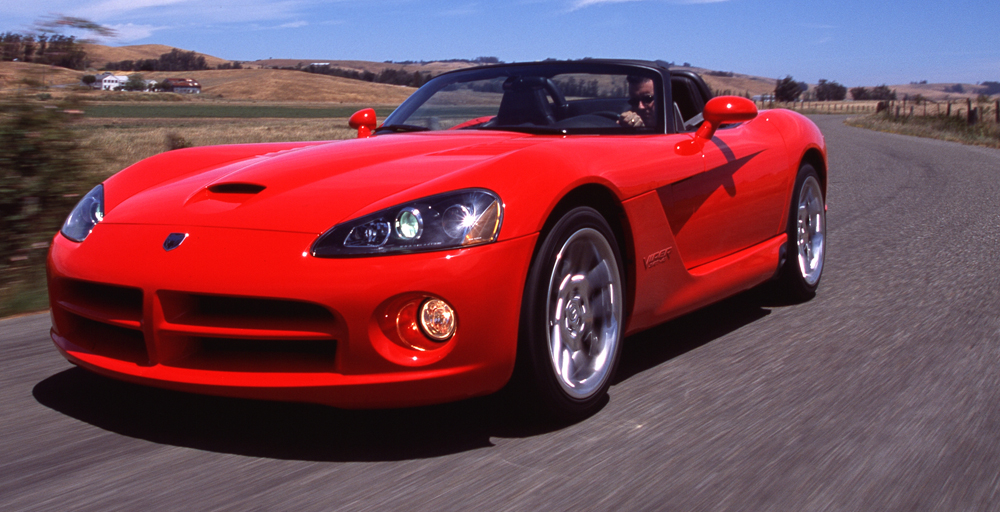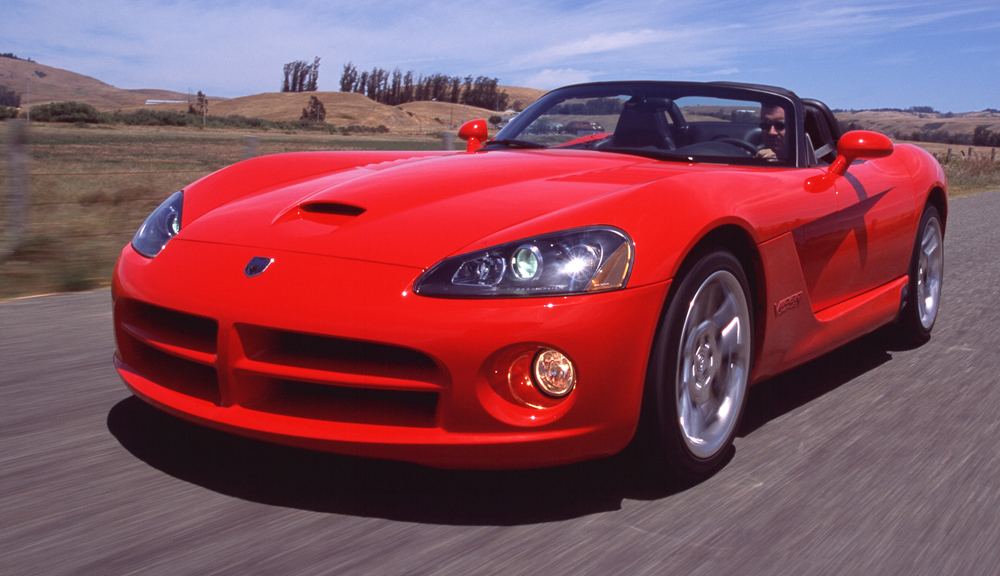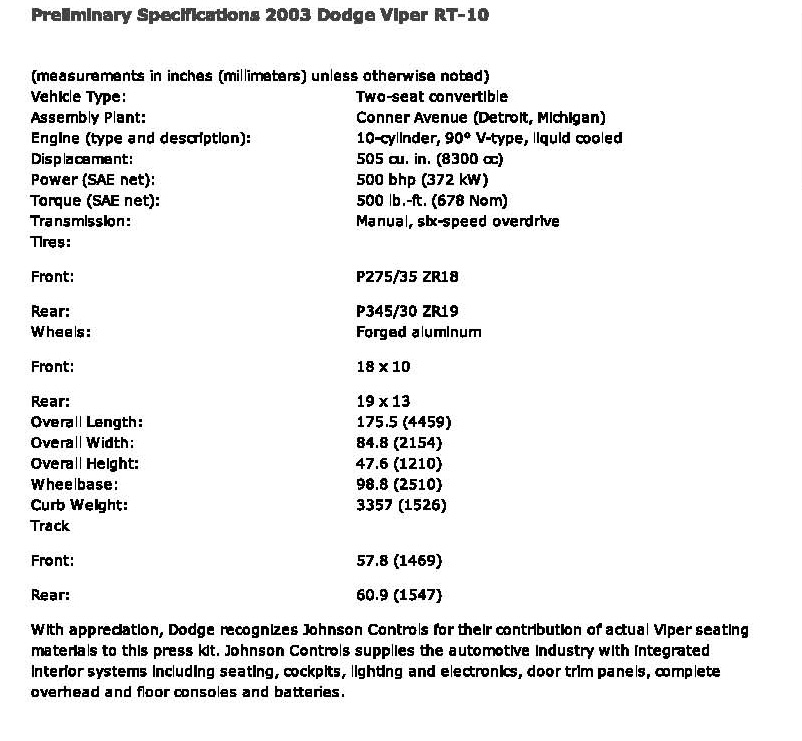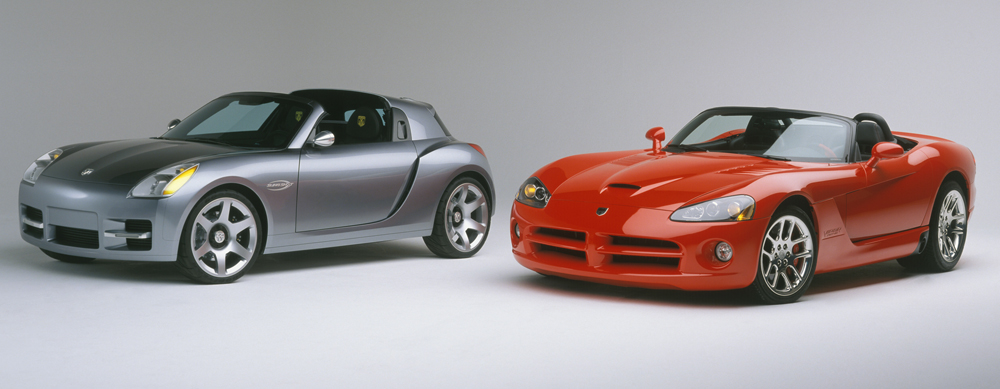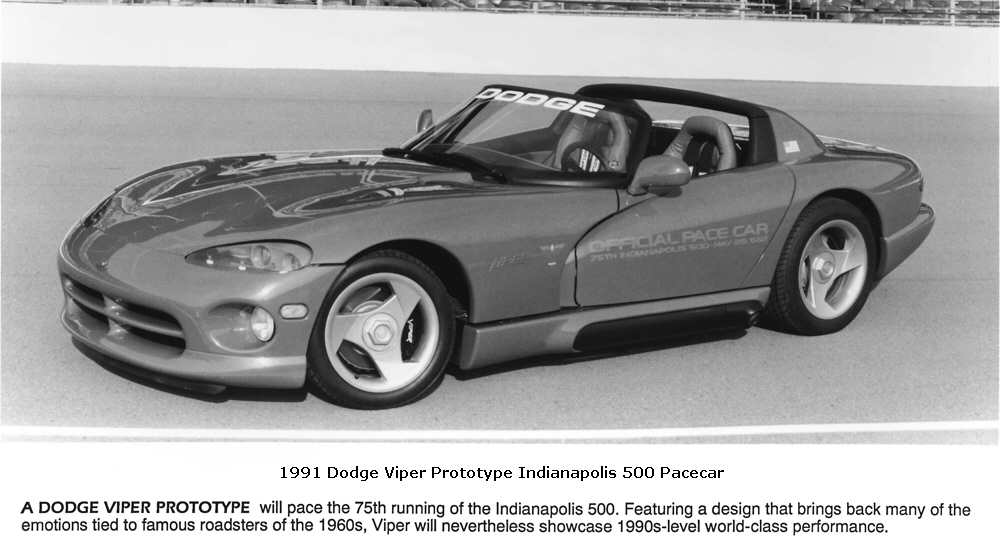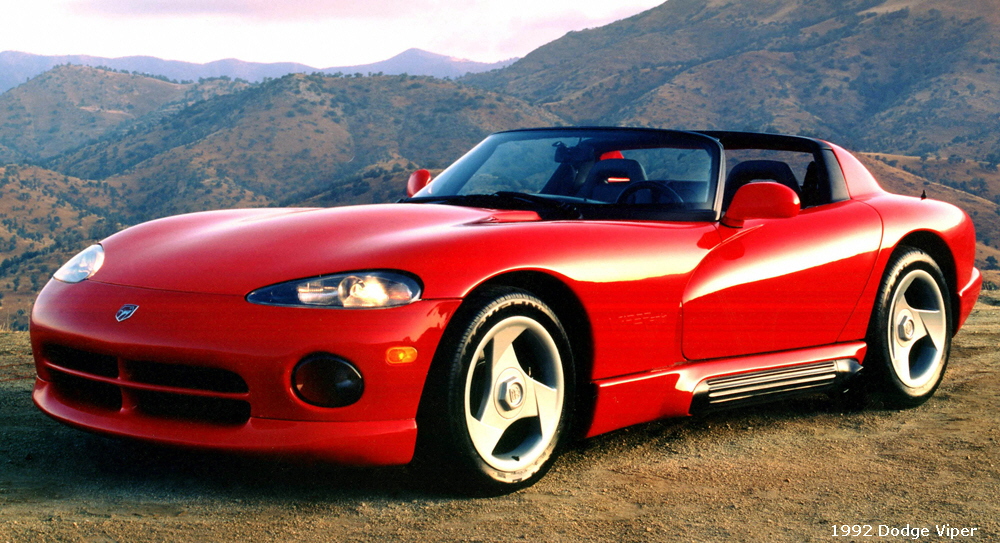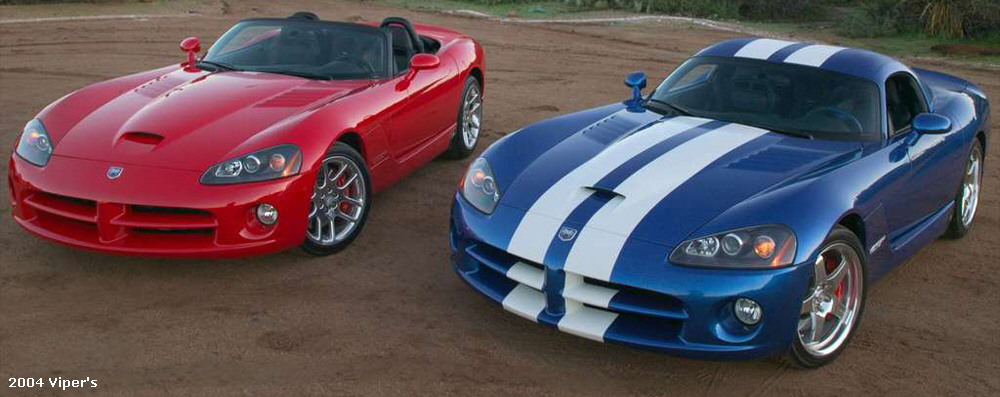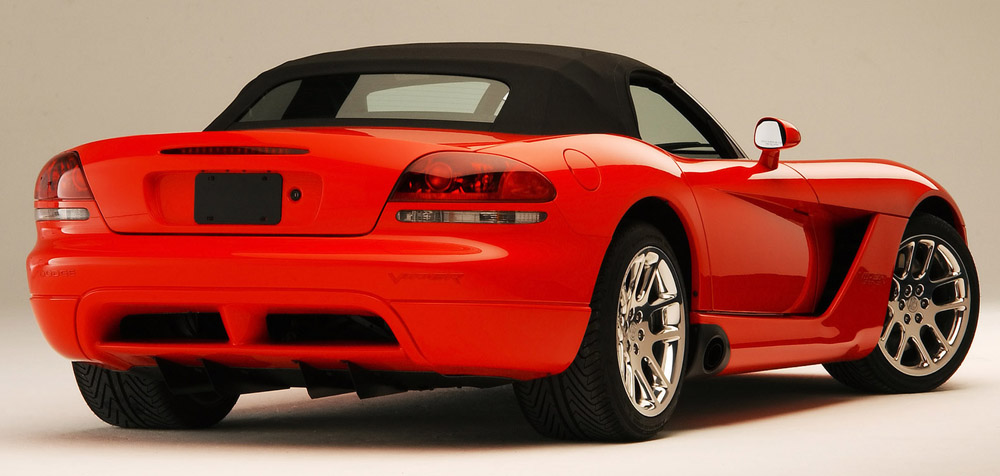|
|
|
|
2003 DODGE VIPER REVEALThe 2003 Dodge Viper RT-10 Convertible: Chapter Three in a Legendary Supercar's HistoryThe Dodge Viper has always been more than just a car. To enthusiasts, it represents the purest expression of free-spirited driving. For a re-emerging Chrysler Corporation, it heralded a new way of doing business, taking chances and stepping over the edge. To the industry, it served as a wake-up call that the Dodge brand would be the catalyst for change in automotive design throughout the 1990s. Beneath its iconic imagery, the Dodge Viper has backed up its reputation with cold, hard numbers - horsepower, torque, 0-60 mph, 1/4-mile, slalom, skid pad and top speed. Unlike the pseudo-sports cars that pop up every year or so from other car makers, at Dodge, slick copy has never been a replacement for raw performance. So when it came to write the third chapter in the remarkable story of America's only true supercar, Dodge once again defied convention and built the all-new 2003 Viper lighter, faster and more powerful than ever. This chapter's subhead echoes the enthusiast mantra: "There's no replacement for cubic displacement." "When we introduced the first Viper, we set the principles that would forever define the car - obscene performance, outrageous design and ultimate driver enjoyment," said Jim Julow, Vice President, Dodge Global Brand Center, DaimlerChrysler Corporation. "With this next chapter, we've stayed true to those principles in creating the next version of the ultimate American sports car." The next chapter of Viper takes extreme performance further than Dodge has ever taken it before, reaching a Holy Grail of sorts for those worshiping the religion of extreme automotive performance. The Dodge Viper will become the only production car in the world to develop at least 500 horsepower, 500 lb.-ft. of torque and feature an engine with more than 500 cubic inches of displacement. "When you want to increase the capability of a high-performance car, there are three basic areas you can change: increase the power, reduce the weight or improve handling," said Larry Lyons, Vice President, Small Car Platform Engineering, DaimlerChrysler. "For the new Viper, we did all three." The Viper once again underscores the core philosophies of the Dodge brand by being the ultimate automotive icon for extreme performance and extreme attitude.
500/500/500 Performance / Bring back the big blocks! With performance upgrades that will increase its displacement from 488 to 505 cu. in. and push its V-10 power output to a whopping 500 horsepower and 500 lb.-ft. of torque, Viper has no equal on the road. The 8.3-liter all-aluminum big-block engine drives huge 19-inch rear wheels and anchors a performance package that eschews technical gimmickry in favor of traditional engineering virtues. The spirit of America's muscle cars lives within the Dodge Viper. Race-Bred Chassis In creating the next chapter of Dodge Viper, the mission was to enhance its unfiltered blend of performance. Viper retains a traditional front-engine, rear-wheel drive layout with six-speed manual transmission. The commitment was made early on to use a racing-style chassis including fully independent four-wheel suspension, huge tires and wheels for maximum grip and massive brakes for stopping power. A new version of the Viper's four-wheel anti-lock disc brake system, originally introduced for the 2001 model year, will be enhanced on this next-generation car. Body by Dodge With styling cues derived from the Dodge Viper GTS/R concept car first shown at the 2000 North American International Auto Show, the all-new 2003 Dodge Viper RT-10 convertible packs an outrageous new design into a low-slung roadster shell. Lowered hood lines, swept-back fenders and deep-cut side scallops take their cues from the classic original, yet bring the Viper into the 21st century. Improved aerodynamics and a full-length undertray add functional performance enhancements. Viper's visceral lines speak volumes for the passion that Dodge designers bring to their craft. The new Viper gives enthusiasts an American sports car that remains true to the credo of pure performance. Interior Fits Drivers Like a Glove The next chapter of Dodge Viper continues to set the definition of "extreme," yet features greater levels of refinement and finish. Viper retains its essence - its "Viperness" - while taking natural steps forward. A race-derived two-seat cockpit looks over a highly functional instrument panel with center-mounted tachometer and a 220 mile-per-hour speedometer, giving a clue as to the production car's top-speed potential. A push-button starter refires old-time sports car memories. There's no mistaking that the driver is in command at Viper's helm. Viper is the automotive equivalent of a jet fighter, and at the pilot's command, launches off the line like a Hornet from a carrier catapult. Viper Redfines the Convertible The new Viper has a new roofline profile with an easy-to-operate drop top. The Dodge Viper was initially introduced with a full-width sport bar that brought open-air motoring to the Dodge lineup. The second chapter of Viper history was written when an all-new GTS Coupe joined the Roadster for 1996, and added classic gran tourismo styling to match the car's prodigious performance capabilities. The new Viper's bi-fold clam shell top with single center latch now makes it a true convertible, and harks back to a time when sports cars delivered serious performance capabilities and stood for untamed freedom.
True to the Mission Team Viper set out five goals in creating the next generation car:
"With its dramatic styling, 500/500/500 performance and racing pedigree, the Dodge Viper is unlike any other car on the road and expresses a style and attitude only Dodge could deliver," Julow said. "Viper has earned the title of Ultimate American Sports Car." The Dodge Viper will go on sale in August 2002 as a 2003 model. It will be built at DaimlerChrysler's Conner Avenue Assembly Plant in Detroit, Michigan.
Dodge Viper - A Short But Amazing HistoryFor every generation there is one automobile which completely captures the imagination of driving enthusiasts, transforming the idea of transportation into the ideal of art. Names like Cunningham, Allard, Cobra and Testa Rossa come to mind - cars which combined blinding performance with exceptional form. Since its debut as a concept vehicle early in 1989, the Dodge Viper earned the reputation of the quintessential American sports car. Big-blocked, attention grabbing, fast, loud, untamed and uncompromising, the Viper stands out as a modern standard-bearer for pure American heritage and tradition. Beginnings It all began as a tiny spark in the minds of a few dedicated car enthusiasts at the former Chrysler Corporation, and quickly flamed into the shared passion of a group of like-minded individuals which came to be known as Team Viper. Foremost in the minds of Team Viper's first members was the idea that a truly legendary automobile could only be created by eliminating virtually all extraneous considerations. The most important thing was to move one or two persons as quickly as possible and with as much raw performance as the driver could draw from a powerful engine and a responsive chassis. Their specific performance benchmark was to accelerate from zero to 100 mph and to decelerate to zero again in less than 15 seconds. (Officially achieved with a United States Auto Club-sanctioned 0-100-0 run of 14.78 seconds in 1993.) They believed Viper's body should recapture the essence of classic sports car design in a truly modern idiom. It had to tightly encompass a hardware package that would include huge tires and wheels, a powerful V-10 engine and a simple, yet spacious two-seat interior. Among the benchmarks: the Cunningham, a limited-production Chrysler HemiĀ®-powered race car that successfully competed head-to-head with the cream of Europe's celebrated marques in the early 1950s. Star of the Show With these ideas in mind, a one-of-a-kind Viper RT/10 show car was designed and engineered at Chrysler Corporation's Advanced Styling Studio. It first appeared to the public on January 4, 1989 at the North American International Auto Show in Detroit, with the goal of testing public reaction to the concept of a back-to-basics, high-performance, limited-production sports car. The reaction was overwhelming to say the least. Orders began to flow in even before the show was over. Chrysler Corporation immediately decided to determine the production feasibility of transforming the crowd-pleasing Viper RT/10 show car into a limited-production sports car in no more than three years. In the months that followed, Team Viper conducted numerous meetings with potential suppliers, studied manufacturing techniques and analyzed various engineering approaches that would allow them to produce this unique roadster within a set timeframe and budget. In May of 1990, the months of intensive study and testing culminated in the announcement by Chrysler Corporation that the V-10-powered Viper was a "go." Now it became a matter of people utilizing computers and car-building smarts to find and develop the most efficient ways of doing things. Initial production of the Dodge Viper RT/10 was scheduled to begin in just 18 months. Early Development Once the initial idea had been accepted, the decision was made to develop the Viper RT/10 using a platform team concept. The result was an independent group which existed within Chrysler Corporation, establishing its own mission and creating its own supplier base. The team leader sifted through scores of volunteers - Chrysler engineers, designers and managers - in search of a select few self-admitted car fanatics who would do whatever was necessary to create and produce a very special high-performance sports car. Operating in its own highly secured area of a major corporate engineering center, Team Viper began three years of intensive, often around-the-clock operations. Their activities stretched from Italy - where the aluminum engine block was perfected - to the race tracks at Nelson Ledges and Road Atlanta - where they fine-tuned Viper RT/10's unique high-performance chassis and powertrain. Team members worked closely with major automotive suppliers to develop unique components for the Viper RT/10 which would not only withstand the tremendous stresses associated with high-performance driving, but also enhance Viper's considerable performance capabilities. Chassis prototypes, or "mules," were developed to study vehicle dynamics. Within a year of Viper's auto show appearance, a V-8-powered mule was being tested. A few months later, a stablemate powered by a cast iron V-10 joined the test fleet. In May of 1990, after months of intensive study and testing, Chrysler Corporation announced that the Viper, now powered by the aluminum V-10 was a "go." In May of 1991, the Viper RT/10 performed as the official Pace Car of the 75th Indianapolis 500, further fanning the flames of public interest. Finally, in December of 1991, the first red Viper RT/10 production cars rolled off the New Mack Avenue assembly line - exactly three years after the concept car's 1989 auto show triumph.
Continuing the Success In January of 1992, a production version of the Dodge Viper was shown to the public at the North American International Auto Show in Detroit. In April that year, a prototype was donated to the Indianapolis Motor Speedway Hall of Fame Museum. In 1993, black was offered as a second color option. "Tonight Show" host Jay Leno bought the first one. Bright yellow and emerald green were added to the mix in 1994. Viper production moved in November 1995 to the Conner Avenue Assembly Plant, where it remains to this day. The RT/10 was joined by the Viper GTS in 1996. Introduced to the public at the 1994 Detroit Auto Show, it was selected to pace the 1996 Indianapolis 500, with actual production beginning in that very same month - May. Like the Dodge Viper RT/10, the Viper GTS Coupe teased enthusiast appetites well before getting an official green light to build. In August 1995, Dodge displayed a blue with white striped GTS Coupe prototype at the second annual Dodge Viper Owner Invitational in Monterey, Calif., and made an exclusive offer to current owners - a voucher for the first GTS Coupes produced. More than three-quarters of the 1996 calendar year production of 1,700 was instantly spoken for. The Roadster was designed for the aggressive, wind-in-the-hair driver. The GTS Coupe was given the same capacity to exhilarate the senses, but in a more refined manner. The goal was to do more than just add a roof to the Viper. The goal was to create the GTS in the mold of the world's premier Grand Touring cars. The GTS was seen as catering to a broader customer base than the RT/10, including professional people with an interest in performance cars as well as the pure enthusiasts that identify with the Roadster. Planners wanted the Coupe to retain the agility of the Roadster in spite of added amenities of a roof and roll-up windows. To get the Coupe weight down to that of the original Roadster, the car went on a weight-reduction program. While the GTS and the RT/10 look much alike, more than 90 percent of the Coupe was new. Every major part was subjected to scrutiny with telling effect: the GTS with air conditioning weighed nearly 100 pounds less than the 1994 RT/10 without air. Significant changes, introduced on the 1996 Coupe and carried over to the Roadster, reduced weight by 200 pounds. These included an all-aluminum suspension system and re-engineered frame. Other weight reductions were distributed throughout the car. For GTS, weight reduction was focused in the engine and cooling system where more than 80 pounds were removed. A total of 14,000 Vipers now cruise the world's boulevards and racetracks, building a very strong and extremely enthusiastic owner core. Currently there are more than 3,600 members of the Viper Club of America affiliated with 40 Viper Clubs throughout the world, 33 of which are in the United States. There are no other cars truly in the same class as the Dodge Viper GTS Coupe and RT/10 Roadster. And regardless of which model comes to mind, Viper remains true to its original mission: create the ultimate American sports car.
|
|
Home < Chrysler Group < Dodge Vehicles
|
